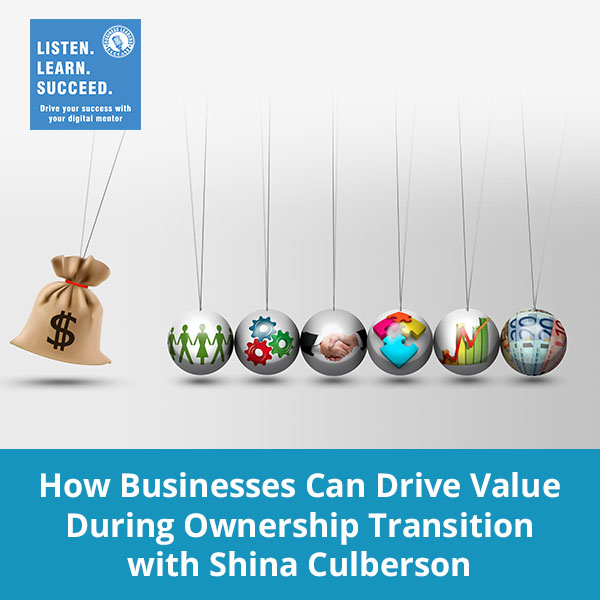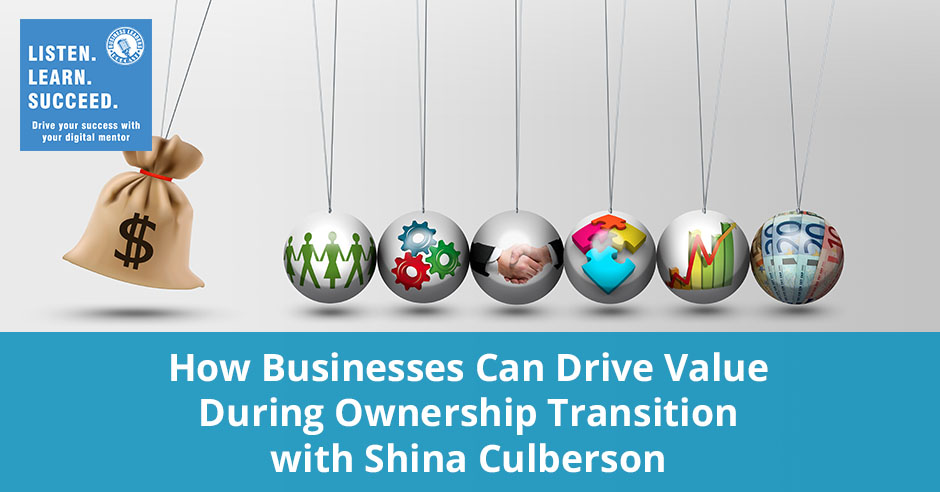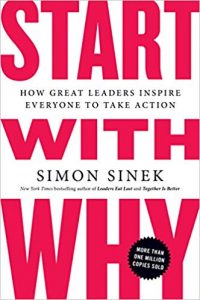How Businesses Can Drive Value During Ownership Transition with Shina Culberson


There will come a time for business owners to start to entertain the idea of ownership transition. In one way or another, they will have to transfer their businesses to the hands of other owners, carrying over not only the business itself but the employees as well. Shina Culberson, chartered financial analyst of Quist Valuation, talks about the processes of valuation and how businesses can drive value. She covers the importance of creating a culture of innovation among employees starting with the customer mind rate. Sharing as well how they lower the barriers of entry to valuation, Shina provides some actionable and deliverable information to business owners as she shares her business journey.
—
How Businesses Can Drive Value During Ownership Transition with Shina Culberson
We are so fortunate, we’re in the world headquarters of Quist Valuation with the President, Shina Culberson. Shina, thank you so much for your time.
Thanks for having me.
Tell us a bit about your business and who you serve?
We are a business valuation firm. Many people don’t know what that means. To make it very simple, what we do is we work with primarily privately held companies and/or family-owned businesses to help them understand if they were to go on or sell their company, what could they sell their company for. What is the dollar value of their company? We work mostly with privately held companies and they can range from anywhere from $2 million in revenue to a billion dollars in revenue. We believe that looking at a broad breadth of clients across various life cycles makes us better at what we do. It provides us contexts when we look at different companies in different industries.
Folks would say, “What makes you qualified to go out and do this? What brought you to business valuation?”
Business valuation experts are also called business appraisers. There is a credentialing involved. I personally hold the Chartered Financial Analyst designation, which I don’t know if you’re familiar with. It’s quite a rigorous designation to obtain. We here at Quist actually support all over our analysts receiving that designation. We hold it in the highest regard. We think it stands out amongst many different designations within the industry. To be qualified, you need to work with somebody who has experience or this is something that they are doing on a full-time basis. I have many friends who are CPAs. They’re very good with numbers like we are, but they’re not necessarily qualified to do business valuation. There are a different financial theory and techniques involved. Finding someone where they’re doing business valuations as their full-time practice would be an important qualifier.
The understatement was that the CFA is a hard thing to get. It’s a very narrow funnel. Very few people come out the other end in the CFA. Then you’re also doing credit analysis for a major investment firm, I believe, in your previous life.
I’ve been an analyst my entire career. I graduated from college with an Economics major and had an Asian Studies minor. I spoke Japanese. I lived in Japan for a little while. My first job was at a Japanese bank in Los Angeles. I started out as a commercial banker. I probably was one of the last people to go through a formal credit training program sponsored by a commercial bank. I moved into asset management with Charles Schwab Investment Management. I covered the international markets. I did credit research for them. That was a fascinating time because I covered financial institutions so I was there when the Euro was launched. I was in Europe talking with the central bank, talking about lender of last resort across Europe. I was around when there was the Russian ruble crisis. The Japanese economy was tanking. It was a fascinating time when I was covering the international markets at Charles Schwab. From there, I did a short stint in mortgage banking. Then I finally found my way here to Quist.
The challenge is you don’t always have customers who are willing to fill out the survey for you.
I think about the qualifications to understand business. Clearly, the credit side matters. You look at balance sheets. For you, typically a potential client comes to talk to you about engaging your service. What are the typical two reasons why a business owner would contact you for your service?
Ultimately at the end of the day, business owners have this idea of ownership transition. It can look many different ways. If you take a startup company, they are also dealing with ownership allocation. They’ve got the founders of that startup company. They’ve got venture capital investment and so they have preferred shareholders. They’re also working with retaining employees. They’re looking at issuing them maybe some options. All has to do with capital structure, ownership structure, ownership transition.
For a startup company, business owners who come to us primarily for that stock option program or to raise capital. Other business owners might come to us because they’re doing some complex tax and estate planning work, which is about ownership transition at their death, getting those plans set up today to create efficiencies for wealth transfer. Hopefully, many years and decades down the line when their state passes onto the next generation. The other reason a lot of business owners work with us is that they’re trying to bring in a management team into the ownership structure or an identified key employee that they want to retain. They want a mechanism for bringing them into that ownership structure and incentivizing them to eventually take over the business so they can retire.
I had a little exposure in the exit space. When you go and do a deep dive into a company by and large, when you’re done where everything’s at, if you’re looking to companies that you’ve done it for and you look at the beginning of one or two years after you’ve done it, what are the biggest changes or transformations you see in that company after the owner has the analysis done?
When we talk with business owners, we focus on six business value drivers, but I will tell you that it comes down to number three. I believe they are easy to accomplish tasks that a business owner can do for their company. When business owners ask me, “Shina, what are the three simple things I can do for my business to drive value?” One would be, and this sounds silly, do all of your management team members have a clear job description? Do they understand their job description? Are there actions and objectives tied to some sort of financial reward or metric? There’s a clear link between what they’re doing and how they’re going to be rewarded. It sounds simple, but very few companies actually have a very clear link about job descriptions and financial reward. What happens when we get into our business, we start wearing lots of different hats. We start picking up tasks and duties that weren’t part of our position but we’re doing them anyway. Then the job descriptions fall stale very quickly.
It’s an easy thing to do and it’s one of the things that creates clear objectives and outcomes for an organization and especially the management team. That’s one simple thing that we advise business owners to do. The other thing, we ask them about their systems and processes and how they’re documented. How can a business owner or a company continue to create these repeatable processes to have a repeatable revenue stream? Do they have the systems and processes in place to have a guaranteed standard quality of service or product? Do they have great visibility into their revenue? Writing down systems and processes making sure the entire company, employees, and staff understand what those are is not always fun to do, but it’s necessary to create that predictable outcome. When it comes to valuation, predictable cashflow streams is highly important to value.
The third area that we talk with business owners about, and this may sound out of the box a little bit, but it’s innovation. What do they do to continually innovate within the organization? I’m a professional service firm. I think many of my colleagues who run professional service organizations like law firms, accounting firms, they’re like, “What’s to innovate? We provide this service.” As you know people, especially Millennials, they want to receive these services in different ways. Nobody probably knows this more than the wealth advisory industry these days. Having this culture of innovation and how do you keep things fresh and making sure that you’ve got a culture of delivering systems or delivering services and products in a way that clients and customers want to see them and receive them is important. We talk about innovation, which is not normally what you might think about when we’re talking about valuation. We want to see how the company’s thinking about future strategies and business objectives.
 Ownership Transition: There’s a clear link between what your employees are doing and how they’re going to be rewarded.
Ownership Transition: There’s a clear link between what your employees are doing and how they’re going to be rewarded.
There are three things they can do. They can go through, “Why would I want to do that?” It’s because potential buyers will look at those things. You have it redone. If you have them, good for you. If you don’t, your company’s worth less. In the innovation side, let’s say you talked to good old Mr. Smith at company ABC and said, “You don’t have the structure or history innovation here. Here are the one or two things I would recommend you start to do to create the culture of innovation.” What would you tell them?
I would say start with the customer in mind. Most firms don’t have a mechanism for actually serving their customers and knowing if they’re satisfied. What would they like to see differently? Not that you have to address every customer comment, but you can probably start seeing trends about what your customers want to see for your product or service. That creates opportunity and innovation within the organization. It starts with the customer and it probably starts with just you having a way to regularly talk to your customers. Understand how satisfied they are and what would they want to see differently from your organization.
Surely would be simple.
SurveyMonkey would be simple. The challenge is you don’t always have customers who are willing to fill out the survey.
In the other part too, you have a series of customers that has a different idea of what you should do and you go, “Perfect.” Which one is the pearl? We’ve heard Blue Ocean Strategy. For the folks that haven’t read that and are trying to innovate, that’s a good place to start. As you talk into businesses, where it says Quist Valuation on the nameplate, the reality is it’s a whole of more than that on what you guys offer. It’s just not valuation. It’s advice within the business and how to operate. What to do to polish up the balance sheet? For many business owners, what would you say to the business owner, “I’m so busy I don’t have time to gather all this to have a valuation because I already know what it’s worth?”
It’s one of the reasons why we drive our valuation process in a highly systemized way. I think it can feel very overwhelming for business owners if they say, “How long will it take for me to go from the beginning to the end of a valuation process where I can have a report in my hand?” For us, that can be anywhere between six and eight weeks. My goal is to break that six to eight weeks down into one-week sprints so that they can understand in each week what sprint is happening and where their time is needed. When I break it down that way, they realize, “You need me in week one, week three and week six.” You’re doing your internal process in week two before week five. When we can break the process down into a sprint like that and they see what side of the court the ball is sitting at, they realize it doesn’t take that much of their time to perform a business valuation. Hopefully, this will be another good tip for any business and have all their documents well-organized where they can find them. That would be a basic management of the company. A good management of a company is having all your documents in order. That first part of gathering documents isn’t that onerous.
That sounds simple but not necessarily true. You get so busy as a business owner doing what you do. Cashflow, customers, family and all the other things that take up your life and you think about, “I’m not sure if I have time to carve that out.” There’s probably too much to talk about here, but the difference between average and below average investor classes is an enormous difference in the company valuation. For you, when you get done with the valuation you say, “Here are the things that you can do and here’s how and why it matters.” You can change the trajectory of the potential sale price.
We don’t need to be the smartest people in the room in terms of proving it to make someone else feel dumb.
We actually changed the vision and mission of our company. When I first started the organization here at Quist, there was a prideful culture around being the smartest person in the room, being technical experts at what we did. We are a technical expert at what we do. My perspective is we were making ourselves feel good by speaking a lot of technical lingo to business owners. It didn’t serve the business owner. When I came in and became an owner of the company and started running the day-to-day operations of the company, I was dedicated to changing how we spoke to business owners. We’re providing them with information and tangible actionable ways so they can take the information that we provided. We sit down with management teams for hours, two hours, three hours at the time.
We have so much information and insight. To be able to deliver that back to business owners and give them actionable items at the end of the day, to drive value higher in the company, be able to make better decisions and drive performance, that was how we change the vision and mission of the company. We change how we wrote the reports. We change what information we brought to the first page versus the last page. We got away from this idea that we need to be the smartest people in the room. We don’t need to be the smartest people in the room in terms of proving it to make someone else feel dumb. We need to elevate the business owner and give them the actual item that they need for their company.
Did you buy this company eleven years ago?
I started the company eleven years ago and I bought the company in 2012.
You decided to change the nature of the deliverable to where it’s actionable. I’m thinking about your thought process of what was going through your mind, “I’m going to change how we talk to the customer.” What was that like? What drove you to the thought process?
To be honest, frustration. Frustration because we have a six to eight-week process. We sit down with management teams for one, two, three hours at a time. We’ve taken a lot of information. We’ve put a lot of hard work into this deliverable for the client. We would write this 100-page report. A CEO would go to the last page, look at the number and they take the report and put it in their desk. I was sitting at a client’s office here in Boulder. They had been a client of ours for ten years and they were going through some management change. The CEO came in and he’s like, “I’m so glad you’re here. You wrote me this report, but what I need from you is I need you to write me a one-page memo just telling me what are we doing well as an organization and what do we need to improve in the organization?” In pure frustration I say, “If you would just turn to page 36 of the 100-page report, you would get what you needed.” It was a wake-up call for me. “Why is it buried on page 36?” We were already doing the work. We’re already providing the insight but it’s not just packaging.
We did change where we put it in the report, but I also think we change a bit of how we wrote what we believe those strengths and weaknesses were, to make them more actionable. It wasn’t just the company suffers from excess customer concentration. Our largest customer makes up 20% of the revenue. There was more on the company side suffers from excess customer concentration and if they were to do X, Y, Z to reduce that customer concentration, it would create a better predictable revenue and less risk going forward in case of a downturn. Whatever the recommendation was, we just slightly changed how we deliver the information. It’s putting ourselves in the shoes of a business owner, instead of the shoes as the technician. It just changes what we did enough to make it feel more valuable, more tangible, more actionable.
You were sitting on the same side of the table.
It stemmed from a number of frustrating meetings, “I’ve just written a 100-page report and they still don’t know where to find the information that’s most valuable to them.” We have been doing that way for decades.
I think about that and for many of the businesses, it’s hard to get fresh eyes. You go, “I could have moved that to the executive summary, page one.”
It’s putting yourselves in the shoes of your client and what they need. ln hindsight, I should have been asking my clients all along, what’s working? What’s not working? What could be better?
You bought the business at ’12. When did you have a discussion with Eric? Was it before or after ’12?
It was after ’12.
 Ownership Transition: Have all the documents well-organized where you can find them.
Ownership Transition: Have all the documents well-organized where you can find them.
As a business owner talking to another business owner, your perspective is different. You start hearing with different ears. For the business owners that are out there, there are many different reasons why valuations come, some are elective and some are not elective where you have a death, disability, a challenge or disagreement in the partnership. There are so many reasons that valuations are brought to the table. Before I forget to do this, for the guy that’s going, “I like what she has to say, how will I reach out to her?” What’s your contact or social media so they could find you?
I’m on LinkedIn and I post quite a bit on LinkedIn. You can also find us on our website, which is QuistValuation.com.
There’s another exciting thing that you’ve been working on. You have the software.
We have the software. Software stems from two experiences that I’ve had in my tenure here at Quist. One was I had a lot of conversations with business owners over the phone where, to be honest, the price point just was not in their budget for a full-service valuation. Remember I’ve described this 100-page report over six to eight-week process. The business is just like, “I just don’t need something that extensive. Can’t you do something shorter?” It just wasn’t in our business model at the time. What I ended up doing was spending 30-45 minutes or an hour on the phone with them giving away or consulting with them for free, to be honest. It’s tangible, it’s fleeting that information I’m sharing with them. It seemed like there could be a better way for us to provide information and help business owners across all purposes and across all sizes. That’s one thing that was sitting here in the back of my head.
The other observation I was making was that after the market crash of 2008, we all know this trend business owners and Baby Boomers are staying with their businesses longer and longer to make up for the downturn in the market. They were not leaving their companies because they were trying to build them back up. Then we enter a frothy market and it became a seller’s market. For a long time, there’s been some talk about downward pressure on rising interest rates. Soon I knew that the seller’s market was going to turn upside down and it there was going to be too many sellers not enough buyers in the marketplace. What can we do to help those people that were going to be in an inverse situation? Get them prepared in the best way possible for an eventual exit. How to stand out? For me, it was trying to figure out a way to lower the barriers to entry to valuation. I wanted it to be more accessible. I’ve been working on a software platform valuation tool for the last three years that takes all the best practices that we do here internally but putting it on to an online system.
Our full-service valuation process is we sit down with management teams for an hour and a half. It feels very conversational but in our minds, we know that we’re going through a very structured question and answer process. We just took that very structured process of questioning and we put it into an online platform. We broke our questions down into six primary business value drivers. The purpose of that tool is once a business owner goes in and answers these questions, it returns a business score to them. They can see how they’re scoring across their peers, everybody who’s taken this survey. Eventually, we hope to be able to break that score down by segment, the life cycle of the company, and in size. You can just see how you’re scoring against all your peers. Then with some financial information provided by the company, we can provide them with a range, an estimate of value for the company. It literally takes 45 minutes.
There’s so much joy in being able to change cultures, decide, and make decisions to changing people’s lives.
I think about some of the business owners that said, “Yes, that sounds good. I’m going to be talking to a lending institution. I don’t think they’ll understand.” If they go through the valuation, have you found some of the folks who have gone through the software or are using it when they talk to lending institutions?
Everyone in the institution is different in what they require. It depends upon what the collateral is and what the type of business is. It may be sufficient for some banks and it may be insufficient for others. It depends upon their own criteria.
The owner has an idea, which makes him different or her different the minute the other businesses have nothing like this in place who are executed. I think about your departure from Corporate America to being a business owner. At some point, you made a decision to buy that out. What drove you to want to be the business owner? What was the thought process like? You’re at home talking to your spouse you go, “I think I’m going to do this.” What was that like?
To be honest, there was a lot of fear at the prospect of being a business owner. The idea of the weight of the success of the company on my shoulders, the well-being of all the employees, it’s a heavy thing to take on. I’m very fortunate in that it was actually my husband who encouraged me and said, “You need to do this. You’ve already had an owner’s mindset in your position and at your tenure with Quist, this is a financial investment that you’re making, but you’ve been making it in yourself this entire time anyway so you should do it.” I’ve got my husband to thank. He’s the one that got me over the hurdle or fear, “Just to do it.”
I asked this question frequently because a lot of folks are on the fence, “Should I do this? Shouldn’t I do it?” It’s useful to understand the thought process to the decision. I hear many times, “I want to be a business owner.” Do you understand what you’re asking for?
I’ve always had an owner’s mindset. I’ve never thought of myself restricted by a job description per se. I’m a highly competitive person. Whether someone gave me the ball or not, I’m going to take it. Staying in corporate life whether you want me to be running the day-to-day or the president of the company, I was just going to do it anyways. It helps to be highly competitive in nature. That was probably where I started. I’m a business owner. I have to say I probably would never go back to be in a corporate job. There’s so much joy in being able to change cultures, make decisions and change people’s lives. There’s a lot of reward in that.
Shifting gears, what’s an influential book or recent book that you found useful in running your company?
 Start with Why: How Great Leaders Inspire Everyone to Take Action
Start with Why: How Great Leaders Inspire Everyone to Take Action
For me, it was Simon Sinek’s Start with Why. It goes back to the story that I mentioned before. It changed the way that we delivered our service when we stopped focusing on what we did business valuation. We started focusing on why we did it to provide actionable insights to business owners, to improve performance evaluation and management decision making. It changed how we ran our company and it changed the way in how we delivered our services and our product.
The thing that strikes me in your commentary, there are a lot of folks out there, “This is valuation. I’m just doing it because I have to, whatever the reason is. I don’t believe that there’s a premise broadly held that doing this as a business valuation helps you run your business better. I don’t think that’s what most people think when they go through a business valuation. The reality is probably the single most important thing. It’s just good business.
When I tell business owners the reason why you want a business valuation when you don’t need it is just to set a foundation of how to look at your company. Between how to look at all the different variations of your business, whether it be your operations, your management team, your customers, your strategic position in the marketplace, set a foundation and have good practices in how those items translate into a dollar value. If you set those best practices and do them on an annual basis, you can start seeing the trends of where your value is going, where you’re succeeding. It is a great tool for when you want to bring people into to the ownership structure or people want to leave the ownership structure. Some business owners think of it as a little bit of an insurance plan as well. Unfortunately, I’ve been in many situations where people start businesses together and they don’t always work out.
They don’t always end happily. If they’re not working, there are lots of emotions. There’s probably some hurt feelings and it’s a difficult situation. If you start then with the business valuation, then people feel like who’s tainted in this scenario? How can you be impartial? Who are you listening to more? Are you listening to the person who wants the X? Or are you listening to a person who has to stay in the business? All of that could be avoided if you had started with a business valuation earlier and already set the foundation of what business value is and how to look at it. It makes that scenario a no-brainer and it takes all the emotion out of it. Not once a year planning for a shareholder dispute issue, but it’s one of the things that we see the most often, these shareholder buyouts and they’re never easy.
For you, what’s the best allocation of time or initiative that serve the company best and why?
I love this question when I saw it from you. It’s something that business owners ask me all the time, “Should I focus my time on income sheet growth or balance sheet growth?” What that means is income growth is revenue growth and profitability growth. If you think about it, it’s short-term in nature. I have to say it’s where anybody who sells and closing the deal and winning that deal. They are attracted to that income sheet growth because people love to close sales. I love to close sales. Typically, that income sheet growth is something that can be allocated to somebody else; a sales manager, your business development team. You can easily measure their success because those metrics are easily tractable where the business owner should be focusing on or trying is on balance sheet growth.
What is balance sheet growth? That is the investment that you’re putting back into your company. It’s the long-term return on investment that requires strategic thinking and long-term business objectives. When I think about where I spend my time because I’m a sucker for the deal, I can’t get away from it. I love talking to clients. I love solving problems and I want to work with them so badly that it’s hard for me to get out of the business development and sales role. I personally spent about 20% of my time on income sheet growth and the remainder of my time on balance sheet growth. That long-term strategic thinking and vision for the company. It’s hard balancing to achieve and I will be honest, I did not start there. I have a business coach and I’ve been a Vistage member for about seven years. When I started, I was 99.9% in the business. I could not get out of it. It’s taken a long time to get there and it’s conscientious. I have to remind myself on a daily basis where is the best use of my time, how can I put other mechanisms in place to incentivize other people within the organization to drive that income sheet growth, so I can focus on the long-term balance sheet?
Instead of worrying about what’s hidden, just deal with what is in front to move the ball forward.
I think about if we’re all into, “I want the reward for my effort on the sales,” you can tell us, then you go on working on the balance sheet growth that’s a three or five-year reward. You go, “I want this one. The one that I can see this week, next week instead of next year or the following year.” It’s a challenge. I’m interested in what you say for the most unusual habit or what others may consider out of the ordinary that’s helped you or your company most and why?
Most people that know me well know for the fact that I’m a boxer. I go to the boxing gym. That’s where I get to release all my attention, aggravation and irritation out on a punching bag. Every Friday on my husband because my husband goes with me every Friday to the boxing gym and we get in the ring. We put the headgear on, put the boxing gloves on and go through our own version of martial arts therapy every Friday.
You’re an athlete in your background. You’re in martial arts also. I’m sensing a trend here.
The way that I got into boxing is I was asked to do a charity boxing match for people who live here in Colorado. There is a Denver Startup Weekend, there’s a Boulder startup week. For Boulder Startup Week, my boxing gym, The Corner Boxing Club, agreed to take some entrepreneurs who are stressed out. They’re sitting behind a desk, 1000% focus on their company but in tense, high-pressure situations. Take these entrepreneurs, put them through three months of training and then put them against money people: VCs, bankers, professional service providers. They would also go through a three-month training program. At the end of Boulder Startup Week, we would match men and women together. They would do this charity boxing match where we would raise funds.
Is this still going on?
It still goes on. That’s how I originally got into it. When I first started, anybody who lives here in Boulder knows everybody works out. Everybody’s in good shape and everybody eats healthy. You’re like, “How hard can it be?” It’s a fascinating sport once you get into it because it is a thinking man’s sport. There is so much strategy involved in terms of punches, punch count and defense. There’s a lot of aggression irritation and you can just wail and get that piece out of it but you have to be on your toes and think as well, which is why I love the sport. You can’t just sit there and think you’re going to win on just completely brute force. You have to have some strategy as well. It’s not a sport. I remember sitting at my grandfather’s lap as a young girl watching Muhammad Ali. I never would have thought that I would box.
 Ownership Transition: Baby-boomer business owners are staying with their businesses longer and longer to make up for the downturn they experienced in the market.
Ownership Transition: Baby-boomer business owners are staying with their businesses longer and longer to make up for the downturn they experienced in the market.
I think the metaphor’s just awesome. I think about clearly between the entrepreneurs and the VCs, there must have been an interesting series of bouts. Over the past few years, what’s a belief or protocol that you established in the company that’s most impacted the company?
The one protocol that we do is we have a grading system. We look at what we do. Anytime we want to change what we do or improve what we do, we just have a grading system within the organization. We just give ourselves very small calls. I tell the team, “If we think this issue is a C, let’s just get it to a C plus. Let’s not worry too much about what perfect looks like. Let’s just bring it one step what we can do to make it a C plus.” I work with a whole team of analysts that love nothing but tons of information. The more information, the better. What I’ve observed and I think it’s not just my analyst, it’s being an analyst in general, is that very analytical people can get bogged down in this concept of perfection and need more information.
We have to be in a realm of working with imperfect information but still moving the ball forward. Instead of worrying about having 100% perfect information to get to 100% perfect answer, let’s just deal with what we have in front of us to move the ball forward one step. That’s what we do as an organization. What can we do just to move the ball forward one step? We may not ever get to perfect. We may not ever have all the information that we need to be perfect, but we can just move the ball forward. It’s a big fight against that analytical mindset. It’s not an easy thing to do. It sounds simple but it creates a lot of discomforts.
Don’t get bogged down by perfection.
I can remember a million years ago, I was in the military. They said, “We have good news. We’re going to be able to download all this information right to your unit.” I go, “That’s data, not intel. I don’t need data, I need intel.” When I think about the minimum viable product, can you get it out the door? Then can I act on it? If it was right it would be 100% right for the moment and then it changed. What’s an advice that you would offer to a new business owner or a CEO That’s assuming that role for the first time? What would you say to them?
My advice is to start with the end in mind. What does the asset look like? I’m guilty of it. As business owners, we are so much in our business. It’s hard to lift our head up, survey the landscape and understand what is the end goal that I’m trying to attain. It’s a great question to ask business owners upfront in the very beginning. Decisions will be different depending on what that answer is. For business owners that run a family-owned business where a legacy is important, the decisions that they make along the way within their organization are going to be different than that business owner who’s looking to sell to a third party and is looking to maximize value. Not that the culture doesn’t matter, maybe legacy doesn’t matter as much. All those decisions along the way are going to be different depending on what the end goal is. Understanding what the end looks like is important for making decisions within your business.
 Ownership Transition: In sport, you can’t just sit there and think you’re going to win. You have to have some strategy as well.
Ownership Transition: In sport, you can’t just sit there and think you’re going to win. You have to have some strategy as well.
What are the most common misconceptions about your role as president of this company?
The misconception is that I like to make all the decisions as the CEO. I feel like I’m in a position where I have to make decisions, but I don’t want to make all of the decisions. I try to work on creating an environment where I solicit opinion and ideas so that they’re not just mine. We’re already in an organization. We already do work where lots of perspective and differing opinions are valued. I think a lot of times people look and like, “You’re the owner. You’re the CEO. You should make all the decisions.” The last thing I want is to make all the decisions. I want to have buy-in. I think that is a common misconception with lots of business owners.
Looking back your time in the military, the good hallmark of a good unit is it would function as though the leader wasn’t there in the same way. You couldn’t see if he was there or not there. It’s a little bit more challenging in the business community because you are the hierarchy of training and the expectation. Over the past few years, what you should have said no to and why?
I am a people-pleaser. It’s very hard for me to say no, whereas I should have said no a lot more than I should have. My husband often looks at me and says, “I don’t know any person that can put that much on their to-do list and to expect to have all that happen in a single day.” He has to remind me, “You are in charge of your own time.” It is a lesson hard learned to be more proactive about managing my own calendar and learning to say no. I’m still a student.
For your day-to-day operations of the company, people will have either a routine or self-talk that keeps them going. What’s that routine or self-talk that you have going on between your ears to keep you going? For you, clearly being athletic is a key component of what you do and being competitive.
I think that my self-talk has a lot to do with, “Don’t let perfection get in the way.” I, as a business owner, want to be able to not make decisions based on fear. I promised myself that. I was the tail in the dog. I didn’t feel in control. I’m going to stop making decisions based on fear. I’m going to start making just small proactive decisions and just move the ball forward and not get bogged down by perfection. I am an analyst. I’ve been an analyst my entire life so when I talk about the culture of the organization and we as analysts get bogged down by this idea of perfection and wanting perfect information, I’m subject to it. That’s my self-talk. I have to continually tell myself, “Just make a decision. Just move the ball forward with the best information that you can. Know that learning quickly and iterating often is a good thing.” It’s not always innate. I have this person on my shoulder, “Just move forward. Just keep moving.”
 Ownership Transition: In the day-to-day operations of the company, people either have a routine or self-talk that keeps them going.
Ownership Transition: In the day-to-day operations of the company, people either have a routine or self-talk that keeps them going.
For you, what’s a quote that you might find meaningful, one that you use frequently?
The quote that I use that I say probably most often, and a lot of people that know me well hear me say this, “Leadership is an attitude, not a position.” I share this with my children. I share this with my employees. I share this with my peers because I believe that titles and position don’t mean much to me. It’s more about attitude and what you want to accomplish with the time that you have in a certain situation. That is what I value. That’s what I try to teach my kids, my boys every year-round.
If I was to talk to your colleagues and ask them what you’re best at, what would they say and how do you utilize them on a daily basis?
My skills are taking in a lot of disparate information and creating a storyline with that information. It’s something that I’ve tried to impart in the culture of the firm. For example, part of our process for valuation is we have these valuation meetings where the analysts have run their model, they’ve done their management interview. They come in and they present their findings to myself and the director of valuation services. Before we even see a number, I want the analyst to share with me what are the three themes of this company that you’re going to tell me that I should see integrated into every assumption and every methodology that you’ve decided is the right approach to take for this valuation. It’s all about breaking down the noise and the thousands of pieces of individual detail and trying to create a storyline into a big picture of what’s happening.
For example, if an analyst said to me, “When we went out to this company, we know that their business objective is to actually make themselves obsolete. They’re actually putting every bit of money back into innovation to create this new product because they realize that the industry that they’re operating with their product line, the obsolescence is high.” The market opportunity is short. They believe that they have to put all this money back into innovation. From a profitability perspective, probably isn’t making any money because they’re putting all its money back in R&D and expenses to build up the future product lines and services of the company. When we look at the value, we look at profitability would be a metric, but it’s not the only thing that we’re looking at because we’re looking at the long-term investment that they’re putting back into the company with a future opportunity. How realistic that is and how long it’s going to take them to get there.
It’s all about creating a story with the valuations. That’s what happens in my mind too is I take in lots of information. I try to break it down into digestible storylines. When a business owner says to me, “What do you think about my business?” I could say, “This is already what we do. We are talking about your company as a storyline.” We have themes that we talk about. It’s also what we do with the analysts because it helps them step away from the numbers and look at the big picture. Also, if they’re going to talk to the business owner what are they going to say? That is one of my strengths. It’s one of the pieces of the process that I’ve integrated into the company. That wasn’t necessarily embedded in the culture of the firm before I took over in 2012. It just helped me remember all these different companies that we’re in touch with. I can write, “This company has that theme and this company has that theme.” It helps me keep them close organized in my Rolodex in my head.
In the storytelling methodology, storytelling was how knowledge was passed for many eons. That’s part of the premise behind the podcast storytelling. Can you impart audibly what you have between your ears?
I sit on the board for the Colorado Leadership Forum. Whenever we’re thinking about, “What to do with the organization? What’s going to be the story of the organization? Who are we? What is our mission? How are we going to get there? Where are our themes?” I like to think about business strategy is creating a storyline about how you want to live that business strategy.
I appreciate you taking the time and sharing with us all your wisdom.
Links Mentioned:
- Quist Valuation
- LinkedIn – Shina Culberson
- Start with Why
- Blue Ocean Strategy
- The Corner Boxing Club
- QuistValuation.com
About Shina Culberson

As the President of Quist, Shina Culberson brings over two decades of financial and valuation experience to her leadership and guidance of the firm. Known for her direct style and laser focus, Ms. Culberson specializes in business and securities valuation engagements for corporate finance, financial reporting and tax purposes.
Prior to joining Quist, Ms. Culberson was an Equity Analyst for Cohen Independent Research Group where she provided security valuation and investment recommendations on public companies in the biotech, high-tech, and entertainment industries. Additionally, she served as a Director at Charles Schwab Investment Management where she managed the International Credit Research Team covering international financial institutions and emerging market Asia and Latin America sovereign investments. The team covered over 50 debt issuers and had oversight responsibility for approximately $32 billion in portfolio holdings.
Over the course of Ms. Culberson’s successful career, she has participated in hundreds of valuation engagements for public and privately held companies in a number of industries including financial services, biotechnology, software, hardware, oil and gas and entertainment.
Ms. Culberson graduated with a bachelor’s degree in Economics from Claremont McKenna College, holds the CFA designation and is a member of the Society of Analysts in Denver.
Love the show? Subscribe, rate, review, and share!
Join the Business Leaders Podcast Community today:
- businessleaderspodcast.com
- Business Leaders Facebook
- Business Leaders Twitter
- Business Leader LinkedIn
- Business Leaders YouTube
The post How Businesses Can Drive Value During Ownership Transition with Shina Culberson appeared first on My podcast website.